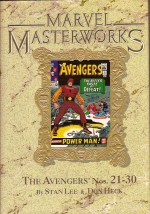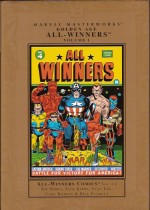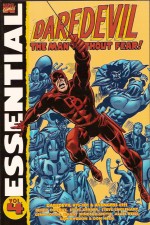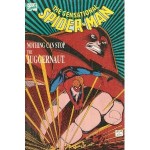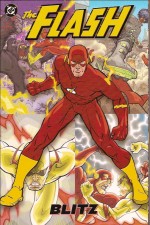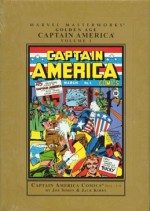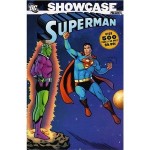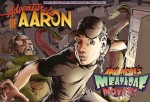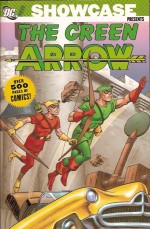
By France Herron, Dave Wood, Jack Kirby, George Papp, Lee Elias & various (DC Comics)
ISBN: 978-1-4012-0785-4
Green Arrow is one of DC’s Golden All-Stars: a fixture of the company’s landscape, in many instances for no discernable reason, more or less continually since his debut in 1941. He was originally created by Mort Weisinger and George Papp for More Fun Comics # 73 as an attempt to expand the company’s superhero portfolio, and in the early years proved quite successful. The bowman and boy partner Speedy were two of the few costumed heroes to survive the end of the Golden Age.
His blatant recombination of Batman and Robin Hood seemed to have very little going for itself but the Emerald Archer has somehow always managed to keep himself in vogue. He carried on adventuring in the back of other heroes’ comicbooks, joined the Justice League of America at the peak of their fame and became the spokes-hero of the anti-establishment generation during the 1960’s “Relevancy Comics†trend, courtesy of Denny O’Neil and Neal Adams.
Under Mike Grell’s stewardship and thanks to the epic miniseries Green Arrow: the Longbow Hunters (DC’s second ‘Prestige Format Mini-Series’ after the groundbreaking success of Miller’s Batman: The Dark Knight Returns) he at last became a headliner: an urban predator dealing with corporate thugs and serial killers rather than costumed goof-balls.
After his long career and a few venue changes, by the time Julie Schwartz’s revivification of the Superhero genre the Emerald Archer was solid second feature in both Adventure and World’s Finest Comics where, as part of the wave of retcons, reworkings and spruce-ups the company administered to all their remaining costumed old soldiers, a fresh start began in the summer of 1958…
This splendidly eclectic collection of the peripatetic Bowman’s perennial second string exploits gathers the pertinent material from Adventure Comics #250-269, World’s Finest Comics #95-140, Justice League of America #4 and his guest-shots in Brave and the Bold #50, 71 and 85, covering the period July 1958 to September 1969.
Part of that revival happily coincided with the return to National Comics of Jack Kirby after the collapse of Mainline: the comics company he and partner Joe Simon had created as part of the Crestwood/Prize publishing combine.
Not long after that groundbreaking move the industry was hit by the Comics Code censorship controversy and a sales downturn that hit many creators very, very hard…
This stunning monochrome compendium opens with ‘The Green Arrows of the World’ (by scripter Dave Wood and Jack with wife Roz inking) wherein heroic masked archers from many nations attended a conference in Star City unaware that a fugitive criminal was lurking within their midst, whilst that same month George Papp illustrated the anonymously scripted ‘Green Arrow vs Red Dart’ in World’s Finest Comics #95, a dashing tale of the Ace Archer’s potential criminal counterpart and his inevitable downfall.
Adventure #251 took a welcome turn to fantastic science fiction as Ed Herron & the Kirbys resolved ‘The Case of the Super-Arrows’ wherein the heroes took possession of high-tech trick shafts from 3000AD, whilst WFC #96 (writer unknown) revealed ‘Five Clues to Danger’ – a classic kidnap mystery made even more impressive by Kirby’s lean, raw illustration.
A rare continued case spanned Adventure‘s #252 and 253 as Wood, Jack & Roz revealed ‘The Mystery of the Giant Arrows’ before Green Arrow and Speedy temporarily became ‘Prisoners of Dimension Zero’ – a spectacular riot of giant aliens and incredible exotic otherworlds, followed in WF #97 with a grand old-school crime-caper in Herron’s ‘The Mystery of the Mechanical Octopus’.
Kirby was going from strength to strength and Adventure #254’s ‘The Green Arrow’s Last Stand’, written by Wood, is a particularly fine example as the Bold Bowmen crashed into a hidden valley where Sioux braves had thrived unchanged since the time of Custer whilst the next issue saw them battle a battalion of Japanese soldiers who refused to surrender their island bunker in ‘The War That Never Ended’ (also by Wood).
World’s Finest #98 almost ended the heroes’ careers in Herron’s ‘The Unmasked Archers’ wherein a practical joke caused the pair to expose themselves to public scrutiny and deadly danger…
During those heady days origins weren’t as important as imaginative situations, storytelling and just plain getting on with it, so co-creators Weisinger & Papp never bothered to provide one, leaving later workmen Herron, Jack & Roz (in Kirby’s penultimate tale before devoting all his energies to the fabulous newspaper strip Sky Masters) to fill in the blanks with ‘The Green Arrow’s First Case’ as the Silver Age superhero revival hit its stride in Adventure Comics #256 (January 1959).
Here we learned how wealthy wastrel Oliver Queen was cast away on a deserted island and learned to use a hand-made bow simply to survive. When a band of scurvy mutineers fetched up on his desolate shores Queen used his newfound skills to defeat them and returned to civilisation with a new career and secret purpose…
Adventure #257’s ‘The Arrows That Failed’ saw a criminal mastermind tamper with the archer’s equipment in a low-key but intriguing yarn by an unknown scripter, most memorable for being the first artistic outing for golden-age great Lee Elias who would become the strip’s sole artist until its demise after Kirby’s spectacular swan-song in WF #99. ‘Crimes Under Glass’ was written by Robert Bernstein and found the GA and Speedy battling cunning criminals with a canny clutch of optical armaments.
Adventure Comics #258 (March 1959) featured a rare cover appearance for the Emerald Archer as he guest-starred in the lead feature ‘Superboy Meets the Young Green Arrow’ by Jerry Coleman & Papp, after which inspiring boyhood on-the-job training the mature bowman then schooled a lost patrol of soldiers in Toxophily (that’s posh talk for archery, folks), desert survival and crime-busting in ‘The Arrow Platoon’: another anonymously scripted yarn limned by Elias.
The same month in WF #100 the Emerald Avenger faced light-hearted lampoonery and sinister larcenists in ‘The Case of the Green Error Clown’ by Herron and the now-firmly entrenched Elias, whilst Adventure #259 showed that ‘The Green Arrow’s Mystery Pupil’ had ulterior and sinister motives for his studies whilst #260 revealed ‘Green Arrow’s New Partner’ to be only a passing worry for Speedy in a clever drama by Bernstein.
World’s Finest #101 introduced a crook who bought or stole outlandish ideas for malevolent purposes in ‘The Battle of the Useless Inventions’ by lead writer Herron, whereas Adventure #261 and the uncredited fable ‘The Curse of the Wizard’s Arrow!’ used bad luck and spurious sorcery to test the Archers’ ingenuity.
WF #102 featured Herron’s snazzy crime-caper ‘The Case of the Camouflage King!’ whilst in Adventure #262 ‘The World’s Worst Archer!’, by Bernstein, finally gave Boy Bowman Speedy an origin of his own and explained how just how narrowly the part-Native American boy Roy Harper came to not being adopted by Oliver Queen, after which #263 ‘Have Arrow – Will Travel’ (Bernstein) saw the independent lad sell his skills to buy a boat… a solid lesson in thrift and good parenting if not reference-checking….
World’s Finest #103 offered a Bob Haney mystery-thriller ‘Challenge of the Phantom Bandit’ after which an anonymous scripter finally bowed to the obvious and dispatched the Emerald Archer to feudal Sherwood Forest in ‘The Green Arrow Robin Hood’ (Adventure #264, September 1959) and WF #104 found GA undercover on a modern Native American Reservation ‘Alias Chief Magic Bow’ (by Herron).
‘The Amateur Arrows!’ (by Bernstein in Adventure #265) had the Battling Bowmen act as Summer Camp tutors on a perilously perfidious Dude Ranch for kids, #266 again saw their trick-shot kit malfunction in a clever conundrum with a surprise mystery guest-star in Bernstein’s ‘The Case of the Vanished Arrows!’ and WF #105 introduced deceptively deadly toy-making terror ‘The Mighty Mr. Miniature’ (Herron).
In Adventure Comics #267 the editors tried another novel experiment in closer continuity. At this time the title starred Superboy with two back-up features following. The first of these starred equally perennial B-list survivor Aquaman who in that tale ‘The Manhunt on Land’ (but not this volume: you’ll need to scoop up Showcase Presents Aquaman volume 1 for the full saga) saw villainous Shark Norton trade territories with Green Arrow’s foe The Wizard. In a rare crossover, both parts of which were written by Bernstein, the two heroes worked the same case with Aquaman fighting on dry land whilst the Emerald Archer pursued his enemy beneath the waves in his impressively innovative strip ‘The Underwater Archers’.
‘The Crimes of the Pneumatic Man’ by Herron, (WF #106) debuted a rather daft balloon-based bandit, whilst Adventure #268 saw another time-trip result in ‘The Green Arrow in King Arthur’s Court!’ by Bernstein who also scripted the February 1960 issue #269 wherein ‘The Comic Book Archer!’ saw the pair aid a cartoonist in need of inspiration and salvation.
That was the hero’s last appearance in Adventure. From then on the Amazing Archers’ only home was World’s Finest Comics, beginning a lengthy and enthralling run from Herron & Elias in #107-112, systematically defeating ‘The Menace of the Mole Men’ – who weren’t what they seemed – and ‘The Creature from the Crater’ – which also wasn’t – before becoming ‘Prisoners of the Giant Bubble’, a clever crime caper loaded with action.
WF 110 introduced photonic pillager ‘The Sinister Spectrum Man’ with a far more memorable menace challenging the heroes in ‘The Crimes of the Clock King’ before a lucky felon discovered their hidden lair and became ‘The Spy in the Arrow-Cave’ a tale that starts weakly but ends on a powerfully poignant high note.
The painfully parochial and patronising tone of the times seeped into the saga of ‘The Amazing Miss Arrowette’ (scripted by Wood) in WF #113 as a hopeful, ambitious Ladies’ Archery competitor tried her very best to become Green Arrow’s main helpmeet. Moreover, in a series famed for absurd gimmick shafts, nothing ever came close to surpassing the Hair-Pin, Needle-and-Thread, Powder-Puff or Lotion Arrows in Bonnie King’s fetching and stylish little quiver…
The times were changing in other aspects, however, and fantasy elements were again popular at the end of 1960, as evidenced by Herron’s teaser in WF #114. ‘Green Arrow’s Alien Ally’ neatly segued into ‘The Mighty Arrow Army’ as the Ace Archers battled a South American dictator and then encountered a sharp-shooting circus chimp in #116’s ‘The Ape Archer’.
A jump to the big time occurred in Justice League of America #4 (April 1961) when Green Arrow was invited to join the world’s Greatest Super-Heroes just in time to save them all – and the Earth for good measure in Gardner Fox, Mike Sekowsky & Bernard Sachs’ epic sci fi extravaganza ‘Doom of the Star Diamond’ before returning to quirkiness and mere crime-crushing in WF #117 and ‘The Cartoon Archer’ by Wood & Elias, wherein a kidnapped cartoonist used caricature as a deadly weapon and desperate life-line…
World’s Finest #118 featured ‘The Return of Miss Arrowette’ (more Wood); a far less cringeworthy effort which nonetheless still managed to make the Bow Babe both competent and imbecilic at the same time, before Herron penned ‘The Man with the Magic Bow’ in #119, with an actual sorcerous antique falling into the greedy hands of a career criminal whilst Oliver Queen and Roy Harper became victims of ‘The Deadly Trophy Hunt’ in #120 and needed a little Arrow action to save the day and their secret identities.
Master scribe John Broome provided a taut and impressive tale of despair and redemption in #121 with ‘The Cop Who Lost his Nerve’ and WF #122 saw ‘The Booby-Trap Bandits’ (Haney) almost destroy our heroes in a tense suspense thriller and Wood wrote one of his very best GA yarns in #123 ‘The Man Who Foretold Disaster’. Herron rose to the challenge in WF 124-125: a brace of bold and grittily terse mini-epics beginning with a breathtaking gang-busting yarn ‘The Case of the Crime Specialists’ and the taut human drama of ‘The Man Who Defied Death’ to pay his son’s medical bills…
‘Dupe of the Decoy Bandits’ by Wood in #126 was another sharp game of cops and robbers whilst George Kashdan revealed the heart-warming identity of ‘Green Arrow’s Secret Partner’ in #127 after which Wood successfully tried his hand at human-scaled melodrama as a retiring cop proved himself ‘The Too-Old Hero’ in #128.
Oddly – perhaps typically – just as the quality of Green Arrow’s adventures steadily improved, his days as a solo star were finally ending. Herron scripted all but one of remaining year’s World’s Finest exploits, beginning with #129’s robotic renegade ‘The Iron Archer’, after which an author unknown contributed ‘The Human Sharks’ as the Bold Bowmen returned to battle crime beneath the seas.
A despondent boy was boosted out of a dire depression by joining his heroes in #131 and ‘A Cure for Billy Jones’ whilst ‘The Green Arrow Dummy’ was an identity-saver and unexpected crook catcher in its own right.
Subterranean thugs accidentally invaded and became ‘The Thing in the Arrowcave’ in #133, whilst ‘The Mystery of the Missing Inventors’ saw a final appearance and proper treatment of Arrowette, but the writing was on the wall. Green Arrow became an alternating feature and didn’t work again until WF #136 and the exotic mystery of ‘The Magician Boss of the Incas’ (September 1963).
A month later Brave and the Bold #50 saw the Ace Archer team-up in a book length adventure with the Martian Manhunter. ‘Wanted – the Capsule Master!’ pitted the newly minted Green Team in a furious fight with marauding extraterrestrial menace Vulkor; a fast-paced thriller by Bob Haney & George Roussos followed by WF #138’s ‘The Secret Face of Funny-Arrow!’ wherein a formerly positive and good natured spoof-performer took a sudden turn into darker and nastier “jokes†and World’s Finest #140 (March 1964) aptly presented ‘The Land of No Return’ by Bill Finger, with the Battling Bowmen falling into a time-locked limbo where heroes from history perpetually strove against deadly beasts and monsters…
The heroes’ decades-long careers ended there and they became nothing more than bit-players in JLA and Teen Titans exploits until Brave and the Bold #71 (April-May 1967) written by Haney and drawn by his Golden Age co-creator George Papp, wherein Green Arrow helped Batman survive ‘The Wrath of the Thunderbird!’ and crush a criminal entrepreneur determined to take over the wealth and resources of the Kijowa Indian Nation.
This volume ends with the first cathartic and thoroughly modern re-imagining of the character which paved the way for the rebellious, riotous, passionately socially-aware avenger of modern times.
Brave and the Bold #85 is arguably the best of an incredible run of team-ups in that title’s prestigious history and certainly the best yarn in this collection. ‘The Senator’s Been Shot!’ reunited Batman and Green Arrow in a superb multi-layered thriller of politics, corruption and cast-iron integrity, wherein Bruce Wayne became a stand-in for a law-maker and the Emerald Archer got a radical make-over that turned him into the fiery liberal gadfly champion of the relevancy generation – and every one since.
Ranging from calamitously repetitive and formulaic – but in a very good and entertaining way – to moments of sublime wonder and excitement, this is genuine mixed bag of Fights ‘n’ Tights swashbuckling with something for everyone and certainly bound to annoy as much as delight. All ages superhero action that’s unmissable. Even if you won’t love it all you’ll hate yourself for missing this spot-on selection.
© 1958-1964, 1967, 1969, 2006 DC Comics. All Rights Reserved.

